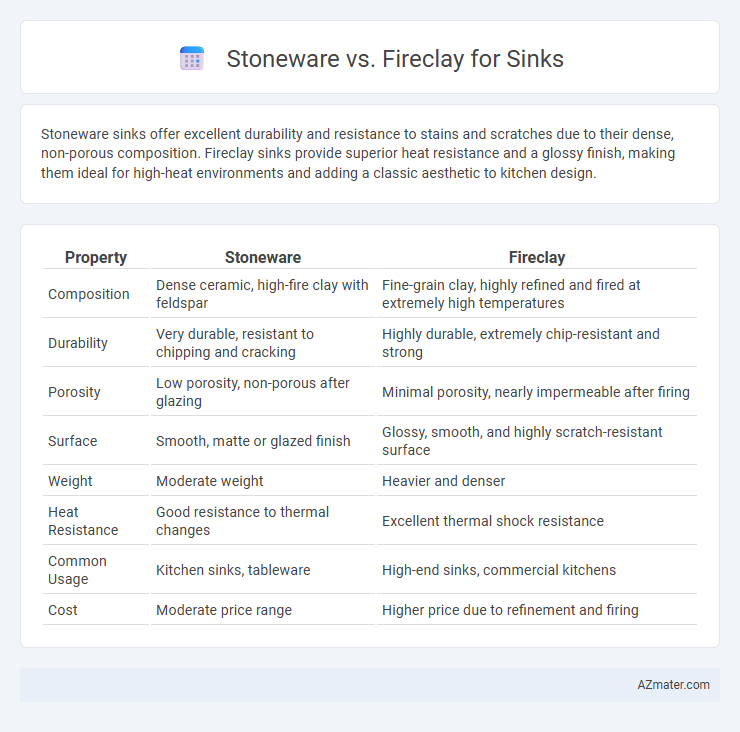Stoneware sinks offer excellent durability and resistance to stains and scratches due to their dense, non-porous composition. Fireclay sinks provide superior heat resistance and a glossy finish, making them ideal for high-heat environments and adding a classic aesthetic to kitchen design.
Table of Comparison
| Property | Stoneware | Fireclay |
|---|---|---|
| Composition | Dense ceramic, high-fire clay with feldspar | Fine-grain clay, highly refined and fired at extremely high temperatures |
| Durability | Very durable, resistant to chipping and cracking | Highly durable, extremely chip-resistant and strong |
| Porosity | Low porosity, non-porous after glazing | Minimal porosity, nearly impermeable after firing |
| Surface | Smooth, matte or glazed finish | Glossy, smooth, and highly scratch-resistant surface |
| Weight | Moderate weight | Heavier and denser |
| Heat Resistance | Good resistance to thermal changes | Excellent thermal shock resistance |
| Common Usage | Kitchen sinks, tableware | High-end sinks, commercial kitchens |
| Cost | Moderate price range | Higher price due to refinement and firing |
Introduction to Stoneware and Fireclay Sinks
Stoneware sinks are crafted from dense, durable clay fired at high temperatures, resulting in a strong, chip-resistant surface ideal for heavy kitchen use. Fireclay sinks are made from refined clay mixtures fired at even higher temperatures, producing a thicker, impervious finish with exceptional resistance to stains and scratches. Both materials offer excellent heat resistance and long-lasting durability, making them popular choices for kitchen and bathroom sinks.
What Is Stoneware? Key Features and Composition
Stoneware is a durable, non-porous ceramic material fired at high temperatures between 1,200degC and 1,300degC, making it resistant to chips, stains, and heat. Its composition primarily includes refined clay mixed with silica and feldspar, which provides strength and a dense, glass-like glaze surface. Stoneware sinks offer excellent durability and low maintenance, making them a popular choice for kitchen and bathroom installations.
What Is Fireclay? Key Features and Composition
Fireclay is a type of ceramic material made from a mixture of refined clay and minerals fired at extremely high temperatures, resulting in a dense, non-porous, and highly durable surface ideal for sinks. Key features of fireclay include exceptional resistance to heat, scratches, and stains, as well as a glossy, smooth finish that maintains its appearance over time. Its composition typically includes kaolin clay combined with feldspar and quartz, creating a vitrified surface that rivals traditional stoneware in strength and longevity.
Durability Comparison: Stoneware vs Fireclay
Stoneware sinks offer excellent durability due to their dense, non-porous composition that resists chipping and cracking under regular use. Fireclay sinks, crafted from fired clay mixed with enamel, provide superior strength and hardness, making them highly resistant to scratches, stains, and heat exposure. Comparing durability, fireclay generally outperforms stoneware with enhanced resistance to impact and surface damage, prolonging lifespan in high-traffic kitchen environments.
Aesthetic Appeal and Design Options
Stoneware sinks offer a smooth, rich glaze with a classic, earthy aesthetic that complements traditional and rustic kitchen designs, while fireclay sinks provide a glossy, bright finish that suits modern and farmhouse styles. Fireclay is highly resistant to stains and scratches, maintaining its vibrant look over time, whereas stoneware's thicker, denser composition allows for more organic texture variations and subtle color differences. Both materials offer a range of shapes and sizes, but fireclay often features sharper lines and more detailed craftsmanship, enhancing its design versatility.
Resistance to Stains, Scratches, and Chips
Fireclay sinks exhibit superior resistance to stains, scratches, and chips due to their high firing temperature and dense, non-porous surface, making them highly durable for daily kitchen use. Stoneware sinks, while also fired at high temperatures, generally possess a slightly more porous surface that can be more prone to staining and minor surface scratches over time. Choosing fireclay ensures enhanced longevity and ease of maintenance, especially in high-traffic kitchen environments where durability is key.
Maintenance and Cleaning Requirements
Stoneware sinks require gentle cleaning with non-abrasive cleaners to maintain their glaze and prevent scratches, and regular wiping helps avoid stains and mineral buildup. Fireclay sinks feature a highly durable, non-porous surface that resists stains and scratches, allowing for easier maintenance with mild detergents and soft cloths. Both materials benefit from prompt cleaning of acidic or abrasive substances to preserve their finish and extend sink longevity.
Cost Differences: Stoneware vs Fireclay Sinks
Stoneware sinks typically range in price from $150 to $400, making them a more budget-friendly option compared to fireclay sinks, which often start around $300 and can exceed $800 depending on design and brand. The higher cost of fireclay sinks reflects their superior durability, resistance to chipping, and a glossy, non-porous finish that resists stains better than stoneware. Homeowners looking for an affordable sink may favor stoneware for cost savings, while those prioritizing longevity and premium aesthetics often invest in fireclay despite the higher price point.
Suitability for Different Kitchen Styles
Stoneware sinks boast a dense, non-porous surface ideal for rustic and traditional kitchen styles, offering a warm, earthy aesthetic that complements farmhouse and country designs. Fireclay sinks provide high durability and a smooth, glossy finish, making them well-suited for modern and contemporary kitchens that emphasize sleekness and easy maintenance. Both materials resist staining and chipping, but fireclay's refined appearance fits minimalist and transitional kitchens where elegance and resilience are key.
Choosing the Right Sink: Stoneware or Fireclay?
Stoneware sinks offer a durable, dense structure with excellent resistance to chipping and staining, making them ideal for heavy kitchen use. Fireclay sinks provide a smoother, non-porous surface with higher resistance to heat and scratches, ensuring long-lasting shine and ease of cleaning. Choosing between stoneware and fireclay depends on prioritizing either toughness and impact resistance or a glossy finish combined with superior heat tolerance.

Infographic: Stoneware vs Fireclay for Sink
 azmater.com
azmater.com